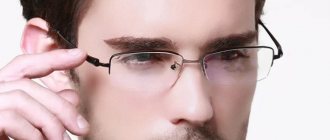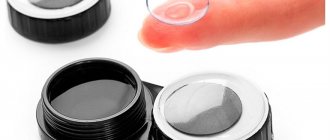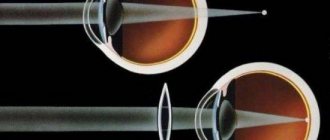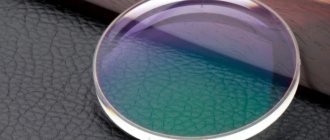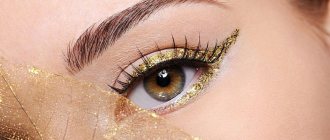Externally, perifocal optics do not differ from traditional spectacle and contact lenses for vision correction.
The essence is the uniform distribution of refractive rays along the periphery of the retina.
Perifocal optics are designed to combat progressive myopia and congenital farsightedness. It forces the entire retina to work.
The approach allows you to slow down the development of myopia, especially in children and adolescents, as the eyeball begins to grow more slowly. In children, optics can completely cure myopia at an early stage.
Features of Perifocal lenses for glasses
Traditional spectacle lenses do not take hyperopic defocus into account. Light rays were concentrated in the center of the retina, and the difference between the refraction of the central and peripheral zones increased even more.
Perifocal glasses have the following advantages:
- They do not require special care. Simply wipe the lenses with a mild soap solution and a flannel cloth.
- You can remove your glasses at any time.
- Equipped with protective coverings from the sun and computer. Keep in mind that such products will cost an order of magnitude more.
- For installation, any medical frame is used, the main thing is that it is possible to adjust the nose pads and temples.
- At the initial stage, complete cure of myopia is possible.
- Do not cause diseases of the retina or cornea.
There are three types of perifocal glasses - Perifocal M, H, P. M - used to correct myopia. Prescribed to patients in childhood with rapid progression of the disease. They prevent the rapid growth of the visual analyzer and stabilize accommodative functions.
H - prescribed to patients to correct farsightedness. This model was developed for children with congenital hyperopia, but then began to be prescribed to adults. By regularly wearing glasses, the eyeball returns to normal size. As a result, the refractive error practically disappears.
P stands for prophylactic. Ophthalmologists recommend the use of glasses for those who constantly experience increased visual stress. Modern materials are used for production - Orma, irwear (polycarbonate), Ormix and Stylis.
Coatings used:
- Crizal Prevencia;
- photochromic;
- polarization.
Perifocal
“Perifocal” is an optical spectacle lens with a stable central refraction and a selective radial progressive or regressive change in refraction at the periphery. The optical properties of the lens can provide differentiated correction of central and peripheral refraction of the eye. The Perifocal lens was developed by the optical surface design laboratory of Inziden Optical Technologies (Spain) under the direction of Professor José Alonso of the University of Madrid (University Complutense of Madrid, Madrid, Spain).
A technical feature of the optical design of the Perifocal lens is the presence in it of a geometric center with a stable refraction and an asymmetric change in refraction on one side and the other relative to the vertical passing through the geometric center of the lens, where on one and the other side relative to the vertical, with an asymmetrical distance from of the geometric center, the refraction monotonically increases (weakens), and relative to the horizontal, passing perpendicular to the vertical through the geometric center, the refraction does not change or monotonically weakens (increases) in relation to the refraction in the geometric center. Thus, when correcting refractive error, the image is focused on the foveal region of the retina with the creation of selective defocus on the periphery of the fundus. In particular, the refraction of the Perifocal lens can ensure that the image is focused in the horizontal meridian in front of the retina, and in the vertical meridian on the retina or behind the retina. Depending on the type of refraction and purpose of the Perifocal lens, its design is implemented in three varieties:
1. Lens “Perifocal - Ms” – a spectacle-corrective prescription lens to inhibit the development/progression of myopia. The additional designation (s) indicates an earlier onset of addition and faster saturation with higher values horizontally relative to the optical center of the lens, in contrast to the already familiar Perifocal-M. Such properties of the lens make it possible to create myopic defocus on the retina earlier, relative to the fovea, to quickly achieve a stronger (0.5 diopter) defocus in the horizontal periphery, in contrast to the Perifocal-M lens, which helps to increase the effectiveness of the therapeutic effect on the progression of myopia.
2. Lens "Perifocal - Msa" - a spectacle-corrective prescription lens for inhibiting the development/progression of myopia with accommodation support. Additional designations (sa), in contrast to Perifocal-M, indicate: (s) – an earlier onset of addition and its faster saturation with higher values horizontally relative to the optical center of the lens (a) – the presence of a zone to support accommodation.
3. The “Perifocal - Ps” is intended for a multifactorial therapeutic effect on the eye and the visual system as a whole in order to prevent the development of myopia in children with predictors of myopia. The central refractive range of the Perifocal-Ps lens is from +0.75D to 0.0D, with a cylinder up to 4.0D. The Perifocal-Ps lens, like the Perifocal-P lens, has an asymmetric progression on both sides of the optical center horizontally, but the magnitude of the nasal (towards the nose) progression is higher and is 2.5 D and has an earlier onset of progression of 4. 5mm from the optical center and a faster saturation progression of 24mm from the optical center horizontally. In turn, the magnitude of the temporal (towards the temple) progression in the Perifocal-Ps lens is also stronger and equal to 3.0D with an earlier onset of progression at 3mm from the optical center and faster saturation of the progression at 24mm from the optical center horizontally. Also, unlike the Perifocal-P lens, the Perifocal-Ps lens is divided into right and left. On the front surface of the lens there is a visible yellow marking indicating its optical center and horizontal (same as on the Perifocal-Ms lens). The Perifocal-Ps lens may have an area to support accommodation and this variety is designated Perifocal-Psa
4. Lens “Perifocal - Psa” - can have a central refraction range from +0.75D to 0.0D, with a cylinder up to 4.0D. The additional designation (a), in contrast to Perifocal-Ps, indicates the presence of a zone to support accommodation. The lens has an asymmetric progression on either side of the optical center horizontally and a downward progression. The magnitude of the nasal (towards the nose) progression is 2.5D with the beginning of the progression at 4.5 mm from the optical center and the saturation of the progression at 24 mm from the optical center horizontally. The magnitude of the temporal (towards the temple) progression is 3.0D with the beginning of the progression at 3mm from the optical center and the saturation of the progression at 24mm from the optical center horizontally. The magnitude of the downward progression is 1.25D with the start of the progression 2mm from the optical center in the downward direction and saturation at 9mm from the optical center, the saturation point of the downward progression is shifted by 2mm towards the nose, relative to the vertical passing through the optical center. One of the important features of the optical design of the Perifocal-Psa lens is the short progression corridor of the accommodative support zone, which, unlike standard progressive accommodative support lenses, provides the user with high motivation to get the visual axis into this zone when working at close range. Also, unlike the Perifocal-P lens, the Perifocal-Psa lens is divided into right and left. The front surface of the lens has visible yellow markings indicating its optical center, horizontal and progression to support accommodation (same as on the Perifocal-Msa lens). Thus, the optical features of Perifocal-Ps and Perifocal-Psa lenses can provide conditions for increasing the effectiveness of therapeutic effects on the eye and the visual system as a whole in preventing the development of myopia in children with predictors of myopia.
Features of Perifocal contact lenses
Contact vision correction products have a high level of humidity. People who work at a computer for a long time are advised to opt for the most humidified models.
The main advantage is the same light load on the retina. Perifocal contact lenses are also divided into Perifocal M, H, P.
Products vary in frequency of replacement, type of hardness (soft and hard), and correction features. PCL is not recommended for use in children as the products require daily cleaning.
Only an ophthalmologist can help you choose the right contact optics. Peculiarities:
- do not interfere with the eyes when working at the computer;
- do not put pressure on the bridge of the nose, since they are located on the eye;
- provide good vision throughout the day;
- Do not dry out your eyes; if this happens, use moisturizing drops prescribed by your ophthalmologist.
One-day PCLs are suitable for everyone. It is recommended to prescribe to teenagers and schoolchildren who do not devote enough time to cleaning. One-day PCLs are put on in the morning and disposed of in the evening. There is no need to purchase storage containers or saline solutions for rinsing. They are safer.
There are semi-annual, quarterly and annual models. PCL with a long period of use should be removed before going to bed, cleaned with saline solution and placed in a special container.
You cannot wear PCL that has a scratch, crack or a small piece missing from the edge. Such products will scratch the cornea of the eye and lead to infection.
Contact perifocal lenses or glasses - which is better?
Contact lenses are prescribed when a person, for some reason, cannot openly wear regular glasses. For example, they get in the way when playing sports, when walking outside in heavy rain, or a person is embarrassed to wear glasses in public. For mild to moderate disease, perifocal contact lenses help as effectively as glasses. In advanced cases, there is no alternative other than glasses or surgery. The patient must decide for himself what he prefers. Naturally, parents decide for their children.
How to wear perifocal glasses and contact lenses
The products are allowed to be worn constantly as a normal means of correcting visual perception. Perifocal optics do not require additional getting used to.
If the patient chooses contact lenses, it will take several days to get used to the presence of a foreign object in the eye. Persons with hypersensitivity are advised to wear for 40-50 minutes a day until the discomfort subsides.
To achieve greater effect, wear the optics up to 2 hours a day. This is sufficient for the initial degree of myopia. In severe stages of development, wearing during the day is allowed. Wearing optics for less than 2 hours a day will not give the desired result.
Glasses do not require special care. Lenses need to be cleaned; protein and lipid deposits accumulate on them.
What are perifocal lenses
In perifocal lenses, light is evenly distributed from the center to the periphery of the retina. This is explained by their special structure. Perifocal lenses consist of three optical zones: for short distance, for medium distance and for far distance. This ensures a clear image of objects across the entire retina.
Let us recall that in conventional lenses only their central part is used, the image is directed strictly to the central fovea of the yellow spot on the retina. Only there can it be perceived as qualitatively as possible. If you turn your gaze, the image is no longer so clear and distinct.
Increase in myopia in the world
Myopia is a vision defect, which in professional medical terminology is called “myopia”. The term "myopia" comes from the Greek word myops - squinting the eyes. Myopic people have trouble seeing distant objects, but they can see objects at close range well. There are three degrees of myopia: weak - with visual acuity up to 3.0 diopters, medium - from 3.25 to 6.00 diopters and high degree - over 6.0 diopters. The prevalence of myopia has recently been growing rapidly, especially in school-age children; for example, in Asian countries (Hong Kong, Taiwan and Singapore) it is diagnosed in 80–90% of schoolchildren. At the same time, in the USA and European countries the number of people with myopia is smaller and amounts to 20–50%. Russia is no exception - according to the results of the All-Russian medical examination, the incidence of myopia in children and adolescents has increased 1.5 times over the past 10 years. Among school graduates, the incidence of myopia reaches 26%, gymnasiums and lyceums – 50%. Myopia in children most often begins at 6–9 years of age and progresses until 16–18 years of age. Its main symptom is decreased distance visual acuity. This occurs due to disruption of the focusing of the image on the retina due to elongation of the eyeball. Progressive myopia in children is one of the most serious problems noted by ophthalmologists. Despite the efforts of specialists to prevent and treat this disease, it often leads to the development of irreversible changes in the fundus of the eye and a significant decrease in vision in working age, followed by a high risk of glaucoma and the development of early cataracts.
Myopia control with multifocal lenses.
The Comet study was conducted at the New England College of Optometry, Boston, 2004.
In which 469 children with myopes aged from 6 to 11 years and refraction from -1.25 to -4.5 diopters took part.
- 235 users used multifocal lenses with an addition of +2.00 diopters over a period of 3 years.
- Single vision lenses were worn by 234 users.
- In the subgroup with esophoria and high PAH accommodation, the effect was 38%
Types of perifocal spectacle lenses
There are three types of such lenses, each of which is designed to correct a specific vision defect:
- Perifocal-M - prescribed to correct progressive myopia in children and adults;
- Perifocal-N - effective for congenital farsightedness (hypermetropia);
- Perifocal-P - not used in the treatment of refractive errors, as it is a prophylactic agent that strengthens the eye muscles and improves the functioning of the retina; This option is especially useful if there is a lot of strain on the eyes, poor accommodation, or the presence of hereditary vision problems.
What is myopia
Normally, light rays passing through the optical media of the eye should be focused on the retina, from where the image is transmitted along the optic nerve to the brain for decoding. With myopia, the following happens: due to the increased length of the eyeball or increased refraction of light in the eye, the rays are focused not on the retina, but in the plane in front of it, as a result of which a blurry picture enters the brain.
If you bring an object closer to your eyes or correct the visual optics of the eye using negative lenses, the focus moves to the retina - and the image acquires the necessary clarity. The mechanism of action of such vision correction is somewhat similar to adjusting binoculars or a camera lens.
Conclusions:
- Bifocal lenses with a horizontal dividing line.
- The effectiveness of bifocal lenses with 3.00 prisms in the right and left eyes was 51%.
There is no significant difference between the eso-, ortho- and exo-groups.
- Bifocal and single vision lenses for near with 3.00 prisms were shown to be effective in the right and left eyes.
- Multifocal lenses.
- Efficiency in stabilizing myopia is 38% over three years with esophoria.
To successfully select the design of Myopilux spectacle lenses, you need to conduct a comprehensive diagnosis to assess all visual functions.
These lenses have contraindications for use! Children with binocular vision disorders (such as strabismus, amblyopia, high anisometropia, nystagmus and other binocular vision disorders). To identify contraindications, it is necessary to conduct a comprehensive diagnosis of your child’s vision by a qualified pediatric ophthalmologist.
To achieve the maximum effect from using Myopilux lenses, the child will use the distance and near zones correctly. It depends on how correctly the frame was chosen, how correctly the special size was made and how well the glasses themselves were assembled.
